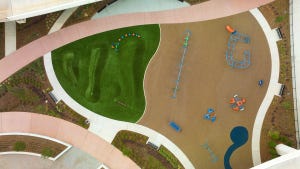An Inclusive Playground is a Smart Playground
This is the third post in a seven part series on inclusive playground design. Read parts one and two. Can’t wait for all seven parts? Request a copy of Me2®: 7 Principles of Inclusive Playground Design® and put research into action.
One question we hear a lot about inclusive playgrounds is “How can I make sure an inclusive playground is beneficial for everyone?” That’s an important question to answer. In the past, playgrounds were often designed to meet the needs of a person or group of people with a specific disability. Some playgrounds added a few “accessible” play activities for children and families with special needs, but the majority of the play space was inaccessible. Neither of these approaches benefit the whole child or the whole community.
That brings us to the third of the 7 Principles of Inclusive Playground Design® - “Be Smart.” An inclusive playground designed to be smart addresses the needs of all children, regardless of ability. The design of the play area is simple and intuitive and makes it easy for everyone to understand where and how to play. For example, various colors, textures, patterns, or plantings can help visually organize the environment. Multi-sensory activities that offer auditory, tactile or visual features can reinforce positive play behaviors and understanding of cause and effect.

Finally, it’s important to define various play settings within the environment to intentionally set clear expectations and create easy to recognize play areas. Active play areas, such as swings, slide exits, or spinning activities are positioned to avoid user conflict. Passive play areas are positioned near other similar areas that can enhance play experiences. For example, a seat and table may be positioned close to a play house or store front panel.

The use of color in the play surfaces and equipment can help define play areas and provide visual cues.
The main takeaway from this principle is this: Organize. Organize the play space in such a way that everyone knows where and how to engage in play. A confusing or complex play space inhibits children from enjoying play and realizing the benefits of inclusive play, but a well-defined play space builds confidence, promotes social and cooperative play and engages every member of the community.
Learn more about the seven principles of inclusive playground design, request a copy of the complete Me2 guidebook or contact a GameTime representative in your neighborhood to explore inclusive play options for your community.
- Trails (27)
- Schools (180)
- Press Releases (102)
- Playground Funding (3)
- Play Science & Research (62)
- Parks & Recreation (339)
- Outdoor Fitness (138)
- National Demonstration Site (32)
- Landscape Architects (72)
- Inclusive Play (101)
- Daycare and Early Learning (62)
- Custom Play (37)
- College Campus (27)
- Churches (50)
- Challenge Course (30)
- Featured Projects (72)
- Site and Shade (6)





